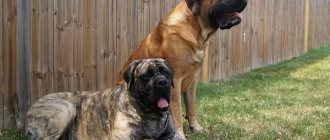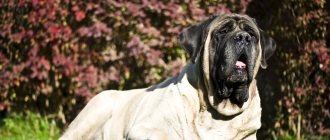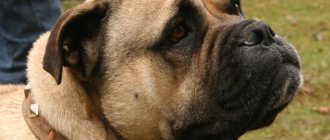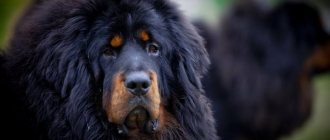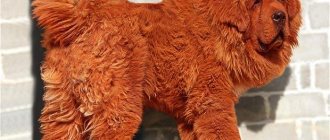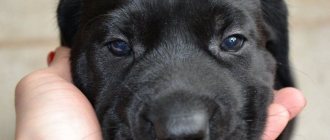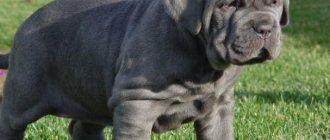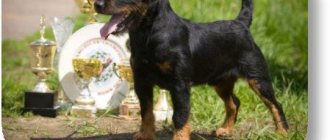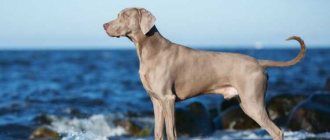- English Mastiff
The English Mastiff is one of the most ancient dog breeds. Their ancestor is the Molossian, which was known 5,000 years ago. They were ferocious war dogs back then. Now they are more of a companion dog.
- Country of origin : UK
- Height at withers : male: 70–91 cm, female: 70–91 cm
- Weight : male: 54–77 kg, female: 73–100 kg
- Lifespan : 6-12 years
- Use : guard, companion dog
Purchasing a mastiff puppy is a responsible and important act that you need to think carefully about before doing. This is especially true for those people who are going to become truly responsible dog breeders. The question of choice should be approached carefully and without haste, comparing your own habits, daily routine and the nature of the chosen breed. When the future owner has decided on the breed, a new dilemma arises: how to find a bona fide breeder? Here you need to be extremely careful not to become a prematurely disappointed dog owner.
Buying a mastiff puppy is a very exciting event, because you can say that a new family member will appear. To ensure that the event does not overshadow anything, it is worth taking a responsible approach to choosing a breeder. There are no bad dog breeds; you can simply run into an unscrupulous breeder for whom money comes first. The future owner is at great risk of buying an animal that has a lot of health problems. It is for this reason that you need, first of all, to get to know the breeder well, read reviews about him and the like.
Breed traits
Breed traits (on a 5-point scale)
| English Mastiff | |||
| Activity | in the house | 1.8 | |
| on the street | 2.5 | ||
| Obedience | training | 3.7 | |
| strangers | 3.9 | ||
| Domination | in family | 1.7 | |
| over dogs | 2.8 | ||
| Defending your territory | from people | 2.6 | |
| from dogs | 3.1 | ||
| Sociability | in family | 4.7 | |
| with strangers | 3.1 | ||
| with dogs | 2.6 | ||
| Concentration | in family | 1.1 | |
| in front of strangers | 2.1 | ||
| with dogs | 2 | ||
| Aggressiveness | in family | 1.2 | |
| to strangers | 2.4 | ||
| to the dogs | 2.8 | ||
| to cats | 1.6 | ||
| Family behavior | calmness | 4.5 | |
| demand for affection | 4.5 | ||
| excitability | 2.9 | ||
| playfulness | 3.8 | ||
| excessive barking | 1.6 | ||
| behavioral breakdowns | 2.2 | ||
| Tolerance for children | up to 4 years | 3.8 | |
| over 4 years old | 4.2 | ||
| Institutional use | watchman | 4.5 | |
| bodyguard | 3 | ||
This breed is often compared to the following dog breeds: Cane Corso, Bullmastiff, Rottweiler, German Shepherd, Caucasian Shepherd.
Photos show what an English Mastiff looks like:
Training
Early socialization is required to prevent aggressive habits. Parenting is done in childhood, teaching the baby to be the leader of the owner.
- They tame obstinacy with tenderness and affection, encouragement with tidbits, trying to earn trust.
- Raising your voice or physical impact is unacceptable; only patience and love can achieve positive results.
- Training takes place for an hour with reinforcement of the material covered.
- The breed is characterized by slowness and passivity; orders are executed after deliberation.
You should not force your pet to repeat it repeatedly for personal pleasure; an intellectual will not want to be a puppet even in the master’s hands.
General characteristics of the breed
The English Mastiff is a powerful, brave protector. He looks formidable, but has a good-natured disposition. From their ancestors, dogs retained courage, strength and protective qualities. Although they are more likely to be “passive guards”. This dog defends its territory, but will never attack unless provoked. He will drive away strangers with his barking and menacing appearance. After all, the peculiarity of the English mastiff is its friendliness towards people. Even towards strangers, he does not show aggression, but wariness.
There are several versions of the origin of the name of the breed. According to one of them, the word mastiffs comes from the Anglo-Saxon masty - “strong”, according to another - from the Latin massivius - “big”. The Oxford Dictionary associates the name with an Old French word that translates to "dog"
| Options | Characteristic |
| Name | English Mastiff |
| country of origin | Great Britain |
| time | 19th century |
| group of breeds according to the ICF classification | Pinschers and Schnauzers, Molossians, Mountain and Swiss Cattle Dogs |
| application | guard, watchman, companion |
| life expectancy | 9-11 years |
| height at withers | males 76-84 cm, females 69-74 cm |
| weight | males 70-85 kg, females 65-75 kg |
| temperament | calm, phlegmatic |
| basic character qualities | stubbornness, loyalty, friendliness, self-control |
| training | complex |
| intelligence | average |
| aggressiveness | average |
| activity | low |
| care | simple |
| noise | No |
An interesting video will give a general impression of the breed:
Video: English Mastiff. Pros and cons, price, how to choose, facts, care, history
Video: This breed is stronger than a bear - English Mastiff
pros
English Mastiffs are dogs that are ideal for people leading a sedentary lifestyle. They love to snuggle next to their owner on the sofa and prefer to stay at home rather than go out for an extra walk, especially in bad weather. Representatives of the breed have many advantages:
- have a calm, gentle character;
- very loyal, attached to the owner;
- love affection, hugs;
- prefer to always be close to the owner, but are not intrusive;
- get along well with other pets;
- not aggressive;
- have excellent guard qualities;
- treat children well, are patient with their whims and pranks, and protect them;
- rarely raise a voice;
- do not need long walks;
- unpretentious to living conditions, do not require complex care.
Minuses
The English Mastiff is not suitable for overly active people, lovers of long walks and hikes, as well as families with small children. And due to their stubborn nature and tendency to dominate, they are not recommended to have as a first dog. It is difficult for a person with disabilities or an old person to cope with this large dog. You also need to take into account that due to the huge size of the English Mastiff, it will not be possible to keep it in a small apartment.
Dogs of this breed have several disadvantages that may become a problem for some owners:
- difficult to learn commands;
- snore in their sleep;
- prone to excessive drooling;
- do not tolerate loneliness well; boredom can destroy the house;
- requires a large amount of food;
- do not tolerate heat well;
- lazy, prone to obesity;
- They shed heavily, and short hair is difficult to remove from carpets and upholstered furniture.
The photographs complement the description of English mastiffs and show the characteristics of the breed:
History of the origin of the breed
English mastiffs are one of the most ancient breeds. Descriptions of dogs similar to them date back to the 6th century. BC e. According to historical documents it is known that around the 3rd-4th century. BC e. they came to England.
The probable ancestor of these dogs was the Tibetan mastiff, which was widespread in Asia at that time. They were used by Roman legionnaires in gladiatorial battles, in war, for hunting lions, tigers and other large animals, and for protection. They were the favorite dogs of Alexander the Great. There is information that he had a dog army of 50 thousand animals.
From the 1st century AD e. Mastiffs were crossed with the fighting dogs of the Saxons and Alans. Then representatives of the breed acquired a dark mask on their muzzle. These large dogs were used for baiting bears, dog fights, and in wars. They were kept mainly by representatives of the nobility; they guarded the owner’s property and helped in hunting.
In the 15th-16th centuries, breeding of mastiffs began, and they stopped crossing them with other breeds. They were widespread, although peasants could not have such large dogs - it was difficult to feed them. At the beginning of the 19th century, when the baiting of animals by dogs was prohibited, representatives of the breed were crushed and by the middle of the century they almost became extinct.
In the 70s of the 19th century, the restoration of the breed began. In 1883, a standard was formed, which changed slightly several more times. But the dogs of that time looked like modern English mastiffs. In the 20th century, due to two world wars, the breed was again on the verge of destruction. Its representatives survived only in their homeland; in other countries at the end of the 40s there were only 14 individuals.
Over the course of 20 years, the number of these dogs was restored, and a modern standard was formed. Now English Mastiffs are popular all over the world. This breed is widespread in Russia.
Photos of modern English mastiffs and images of ancestors:
Grooming activities
Short fur will require minimal care; it is brushed with a bristle brush three times a week, although shedding will force you to do this procedure more often. Bath as needed with a special product. After the bath, avoid drafts, which can lead to a cold.
Clean owners and aesthetes will probably not be able to come to terms with the presence of:
- Excessive salivation;
- Sloppy eating habits;
- Loud snoring;
- Flatulence;
The face and the wrinkles present on it must be cleaned regularly with a damp cloth. Wipe the ears and eyes, brushing the teeth is necessary, especially the back ones to preserve the enamel. Hot weather is not suitable for going outside; due to the brachycephalic type of “face”, breathing becomes difficult.
Appearance of dogs of the English Mastiff breed
English Mastiffs are very large dogs. The height at the withers in males can reach 84 cm or even more. For this parameter, individual representatives of the breed were included in the Guinness Book of Records. One dog named Hercules was 96 cm tall and weighed 127 kg. But on average the weight of dogs is 68-72 kg.
Head
The head is quite large, proportional to the body, almost square in shape. The occipital protuberance is not pronounced. But the forehead and brow ridges protrude. The muzzle is rectangular and of medium length. The stop is smoothed. Folds often form on the forehead. The cheeks are muscular and hang down. The nose is black and wide. The lips are fleshy, adjacent to the jaw, and also black.
The ears are medium length, triangular with rounded tips. Set high and wide. They hang down, touching the dog's cheeks. The eyes are set wide apart. Can be light or dark brown. The eyelids are black and fit well. The look is calm, good-natured. The jaws are square, the teeth are powerful. The bite can be straight or scissor.
Body type
Despite its enormous size, the dog looks proportional. The body format is stretched - the height at the withers is slightly less than the length. Bitches have a more graceful physique, but their muscles are well developed. The neck is thick, slightly arched. There are symmetrical folds on the throat. The ribs are convex, the chest is deep, reaching to the elbows. The back is straight, wide, the loin is convex, the croup is sloping. The stomach is slightly tucked.
The tail is set high. It has a crescent shape, tapering towards the tip. When excited, it rises to the level of the back, but not higher.
Limbs
The forelimbs are muscular and straight. Placed parallel and wide. The shoulders are oblique, the pasterns are massive. The joints on the hind limbs are well defined. The thighs are muscular, the metatarsals are short and strong. The paws are large, arched, and gathered into a ball. The dog moves freely, usually at a heavy trot.
Coat and color
The coat is short and thick. Fits tightly to the body, hard to the touch. Pronounced folds on the muzzle and throat. The undercoat is thick and softer.
The standard allows two-tone colors of English mastiffs. Mandatory black mask on the face and ears. The main color is uniform, it can be apricot, brindle, yellowish-brown, silver. Mustard, sand, chocolate colors are possible. But there should be no spots on the body and a black mask is required.
Disqualifying faults
The standard defines the appearance features of representatives of the breed precisely. If there are slight deviations from it, dogs are not allowed for exhibitions and breeding. The most common disadvantages:
- muzzle short or elongated;
- eyes are bulging or close-set;
- pronounced stop;
- long wool;
- White spots;
- light eyes;
- undefined muscles;
- absence or very light mask on the face;
- arched back;
- clubfoot;
- long ears;
- tail curled over the back;
- incomplete pigmentation of lips and nose
Photos complement the description of the appearance of the breed representatives:
Character of English Mastiffs
The English Mastiff is the calmest dog. Conducts himself with royal grandeur and nobility. Therefore, dogs of this breed can be called English aristocrats. By temperament, they are rather phlegmatic, although they show tender love and devotion to the owner and family members. The mastiff becomes so attached to people that he tries to be constantly nearby. Loves hugs, tries to climb into your lap. Loneliness is unbearable for him, so those who are constantly at work should not get such a dog.
Mastiffs are homebodies, they do not like long walks and will never run away on the street if you let them off the leash. They are quite lazy, their favorite place in the house is a soft chair or sofa, on which they like to lounge and sleep. These dogs need physical activity: they are prone to weight gain. But it is advisable to walk more during walks; mastiffs do not like to run.
There is almost nothing left from the fighting past in the character of the representatives of the breed. Now they are good-natured, loyal companions. Only the protective qualities and the instinct to protect the territory have been preserved. Mastiffs are wary and distrustful of strangers and do not make contact. The dog will closely watch the person, ready to rush to the owner’s defense at the first danger. But he never attacks first. And even when defending the territory, it simply drives the intruder into a corner and waits for the owner. Barks rarely and only for business. This dog's voice is loud and booming.
English Mastiffs love children and treat them tenderly and caringly. But families with children are not recommended to have this breed. Due to its enormous size, the dog can accidentally push a child and injure him. They behave kindly with other dogs and pets. They live calmly in the same house with cats, rodents, birds, if they grew up with them. They care for and protect all family members. But in the absence of socialization, they can show aggression towards dogs of the same sex.
Main character traits of a mastiff:
- good nature;
- tolerance;
- affectionateness;
- devotion;
- reliability;
- stubbornness;
- independence;
- vigilance;
- self-control;
- lack of aggression.
The photographs show the behavioral features of these dogs:
Features of education and training
It is necessary to raise a mastiff from the first day the puppy appears in the house. You need to immediately make it clear who is in charge - these dogs tend to dominate. It is important to find a middle ground: these dogs need firm training, but love tenderness and affection. You cannot be aggressive or rude when communicating with them. Mastiffs do not tolerate commanding tone; when communicating with them, you need to negotiate.
This dog becomes an adult late; for a long time it can behave like a playful puppy. But training mastiffs is difficult not only because of this. They are stubborn and lazy. Therefore, many representatives of the breed are able to learn only basic commands, and even then with difficulty. But there are those who strive to please their beloved owner and do everything he asks.
Therefore, the main rule of training this pet is love and affection. Be sure to encourage every success, reinforce it with praise and treats. Classes should not be long - these dogs get tired quickly. You should not force your mastiff to repeat the same thing over and over again. But you need to learn the commands gradually, regularly repeating what you have learned.
The English Mastiff is a born guard, watchman and bodyguard. He has strong instincts to protect his territory and those he considers family. There is no need to specially train him in defense or protection. You can leave him to guard some object, he will never leave his post.
Training should focus on basic commands, socialization and obedience. It is recommended to undergo OKD under the guidance of an experienced dog handler at 6-8 months. When training on your own, you need to take into account that these dogs are slow and lazy. They may be reluctant to carry out even a familiar command.
From the video you can learn about the behavior and training of mastiffs:
Video: English Mastiff follows commands!
Video: English Mastiff and child
Education and training
Despite their passivity and laziness, Great Danes are very smart. They always understand what their owner wants from them, even if they don’t show it. They are in great need of early socialization and training. A large dog must be trained to obey from childhood, otherwise it will create a lot of problems for its owners as it grows up.
The English Mastiff is extremely difficult to move, as it is huge and impenetrable. Therefore, first of all, teach him to respond to your name. Call him by name loudly, and after he looks into your eyes, reacting to the sound, pat him on the head.
Every time the dog responds to your call, give it a command, for example, to lie down. This is how she learns submission, realizing that there is a hierarchy in the family and she occupies the last step in it. All family members should raise the dog in the same way so that he begins to respect each of them.
Of course, its owner plays a separate role in raising a mastiff. This person has a great responsibility. He should encourage the dog’s desire to protect household members and protect them from strangers.
Whenever a young specimen of the breed begins to show signs of aggression towards people outside its territory, gently pat it on the head and express your approval verbally. Thanks to this, he will understand that he is taking the right action.
Never leave unpunished a groundless manifestation of aggression on the part of your ward. He should not be angry with the person whom his master personally let into the house. Otherwise, remove the dog by locking him in the enclosure. There is a simple way to train guard dogs to be tolerant of strangers. It consists of the following:
- Place a collar around your dog's neck and attach a leash to it. Stand with him near the front door.
- Invite an assistant, a stranger to him, to enter your yard.
- Ask him to slowly move towards you with the dog.
- Every time the mastiff growls or barks at the guest, pull the leash firmly so that he experiences an unpleasant burning sensation in the neck area.
- At the last stage, shake the assistant's hand in the presence of the mentee.
Thanks to this simple exercise, he will quickly learn to react adequately to people coming into the house. There are many other activities that allow you to train individual skills in mastiffs.
For example, if you want to raise him to be a bodyguard, then go into nature, again, with an assistant, and train together to knock him down. Typically, such exercises take place in the presence of a professional dog handler.
Keeping English Mastiff dogs
Mastiffs live calmly in any conditions. But due to its large size, it is better to keep such a dog in a large house with a plot. She needs space, although she doesn't like to run. In bad weather, it is necessary to let the dog into the house. Representatives of the breed cannot tolerate heat and frost. Therefore, when taking your dog outside in winter, it is advisable to wear protective overalls. In summer, walk only in the morning and evening.
It is not recommended to keep a mastiff in an enclosure or on a chain; without communication with a person, he will be sad and may become embittered. The puppy needs to be allocated a separate place in the house. It is better to lay a soft bed - these dogs love comfort.
Care
Caring for this dog is easy. The most common hygiene procedures are required:
- once a week, wipe your eyes with boiled water or chamomile decoction;
- regularly inspect and clean your ears, you can use hydrogen peroxide or a special lotion;
- Trim the nails of these dogs 2 times a month; these dogs don’t wear them well when walking;
- Brush the coat once a week with a stiff bristle brush, and daily during shedding;
- To make the wool shiny, you can wipe it with a piece of suede;
- It is enough to bathe your pet 3-4 times a year, this is problematic, since mastiffs do not like water;
- after a walk, you need to wash your paws, and if necessary, your stomach; you can wipe the fur with a damp towel if it gets dirty;
- Once a week you need to brush your teeth with a special paste; due to the special structure of the jaws, dogs often develop tartar;
- After each meal, it is recommended to wipe the folds on the face; food can become clogged in them, which will lead to the development of inflammation.
Health
On average, mastiffs live about 10 years. But with proper care, a balanced diet and suitable physical activity, they can live at least 12-13 years. There are known individuals that lived up to 15-17 years. It is necessary to protect your pet from diseases and get all vaccinations on time. Be sure to regularly carry out the prevention of helminthiases and treat the fur from external parasites. It is necessary to visit the veterinarian regularly in order to detect a possible disease in time.
Dogs of this breed are prone to injuries and dislocations of limbs. Due to the structure of their muzzle, they have breathing problems. The following congenital or acquired diseases are also common:
- bloating, volvulus;
- joint dysplasia;
- inflammatory diseases of the joints;
- osteoporosis;
- diseases of the organs of vision;
- skin diseases;
- urolithiasis disease;
- allergic reactions;
- obesity;
- pathologies of the cardiovascular system;
- epilepsy;
- hypothyroidism
Nutrition
An adult English Mastiff eats a lot and is not picky about its diet. About 1.3-1.5 kg of food is consumed daily. But you should not overfeed your dog, and due to the tendency to allergies, you need to choose food carefully. Depending on age, the puppy is fed 5 to 3 times a day. Adult mastiff – 2 times a day. You can choose natural feeding or dry food.
The most suitable natural foods for eating are lean meat: beef, turkey, rabbit. You can give brain bones, cartilage, offal: tripe, lung, heart, liver. It is useful to give sea fish a couple of times a week. You can supplement the meat with cereals, but these dogs are often allergic to cereals. Vegetables, fruits, and dairy products are healthy. Additionally, vitamins, calcium, bone meal, and fish oil are added to the food.
It is prohibited to give your pet:
- fat meat;
- salty, fried foods;
- canned food, semi-finished products;
- mushrooms;
- legumes;
- smoked meats, sausages;
- sweets, chocolate, confectionery;
- fresh bread, pastries;
- wheat;
- berries;
- whole milk.
It is easier to control the amount of food and nutrient content when feeding dry food. The best food for representatives of this breed: Brit, Bosch, Pronature Holistic, Royal Canin, Happy Dog, Purina. You need to choose varieties that are specifically designed for large dogs.
You cannot mix the two types of feeding; mastiffs are prone to digestive problems. The dog should always have fresh water freely available. You just need to make sure that your pet does not drink immediately after eating, as it may cause bloating. Water should be bottled or filtered; raw water from the tap is not recommended.
Possible diseases and methods of treating them
Large dogs often suffer from the rapid development of hip dysplasia. Sick animals cannot walk smoothly and often have severe pain in the leg area. How can I help them? Usually, the discomfort associated with dysplasia is relieved with painkillers. They are prescribed by a veterinarian. It is this specialist who prescribes treatment in each specific case.
And some Great Danes periodically experience food allergies. The reason is the frequent consumption of sweets with fatty foods. To avoid the risk of adverse reactions in your pets, give them dry food twice a day.
How to buy an English Mastiff puppy
The English Mastiff is popular not only in the world, but also in Russia. Therefore, buying a purebred puppy is not a problem. But it is recommended to contact a nursery or a responsible breeder. You can find them on various sites on the Internet or when visiting exhibitions.
The price of a puppy in Moscow starts from 30 thousand rubles. A dog from champion parents can be bought for 50-80 thousand. Elite puppies cost more than 100 thousand rubles. According to advertisements or on the market, you can buy a baby cheaper, but there is no guarantee that it will be a purebred dog without genetic diseases or abnormalities in appearance.
When choosing, you need to pay attention to the living conditions of the animals and the behavior of the mother. Study the pedigree, certificates from the veterinarian. Puppies of this breed are sold at 2-3 months. At this age they are already capable of independent living. Deviations in character and appearance are also noticeable. When choosing, you need to pay attention to the following signs:
- the fur is shiny, smooth;
- eyes are clear, clean;
- ears without discharge or unpleasant odor;
- the nose is wet and cold, black in color;
- the stomach is not bloated;
- The baby is well-fed, cheerful, not cowardly.
When choosing a sex, you need to take into account that females are calmer and more affectionate. They are more attached to their owner and never run away. But they are more expensive, and they go into heat twice a year. Males are less cunning and less likely to manipulate their owner. They are cheaper, but on the street they can run after a bitch in heat.
The photo shows what puppies of this breed look like:
To understand whether it is worth getting an English Mastiff, watch this video about him:
Video: Dog breed English Mastiff
Video: English Mastiff
Video: English Mastiff - the most powerful fighting dog in the world
The English Mastiff is a loyal and affectionate friend. He is an ideal companion and reliable guard. This is a dog with a stable psyche, calm and patient. Not inclined to show emotions, but becomes very attached to the owner and misses him. The breed is popular in Russia and all over the world, although those who are not familiar with the characteristics of these dogs consider them dangerous and aggressive.
Reproduction and lifespan
The English Mastiff is a very strong and beautiful dog, which is characterized by a sedentary lifestyle. The breeder must be able to distinguish it from the Dogue de Bordeaux. Representatives of these two breeds have many common features, both in appearance and in character. Unfortunately, this wonderful dog has a short lifespan. She lives no more than 10 years, more often 8-9, even with good care.
Males show special sexual interest in females closer to spring, especially when they are in heat. The breeder needs to wait at least 2-3 days, after which he must breed her with a male dog.
Mastiff puppies are born 65-70 days after mating. Usually no more than 6 individuals are born. Males are separated from females at approximately 1.5 months, that is, at the moment of the final formation of their reproductive system.
Important! It is impossible to breed dogs that are close relatives to each other, as they may give birth to unhealthy offspring.
